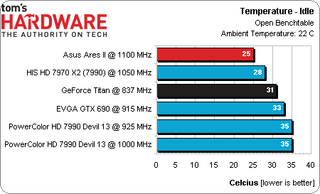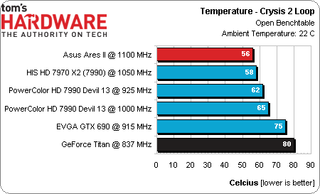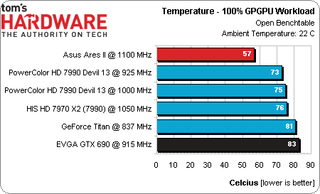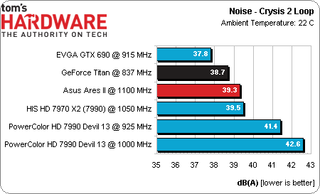Asus' ROG Ares II: Four Dual-GPU Graphics Cards, Compared
Earlier this year, Asus joined the extreme high-end graphics club with its own dual-Tahiti-based card, liquid-cooled and overclocked. You can't buy it anymore, but we got our hands on one and are adding it to our database of performance data.
Noise And Temperatures
Temperatures
The Ares II’s closed-loop liquid cooler isn't particularly quiet, but it does effectively keep the card cool. That's quite an accomplishment.



Noise
We used to measure noise using a regularly-calibrated sound level meter, namely, the SL-400 with data logging by Voltcraft. It only provides good results between a limited frequency range, though. It’s practically useless for frequencies higher than 10 kHz. We needed something else to help us represent the impact of coil squealing. PowerColor's AX7990 6GBD5-A2DHJ Devil13 almost drove us insane with its tinnitus-invoking noise last year. Back then, we decided to use a studio microphone that had been calibrated for our purpose and hung vibration-free. We use the same setup to test Asus' Ares II.

PowerColor would have done better at idle if it hadn’t been for the inductor noise that's above the frequency threshold of modern sound level meters. When the squealing is taken into account, the AX7990 Devil13 ends up in second-to-last place. Together, the Ares' two fans generate a base noise level that's slightly higher than the air-cooled cards at idle.

EVGA's well-built GeForce GTX 690 clearly wins out against the AMD-based competition under a gaming load. It really shows that a pair of GK104s generate a lot less heat than two Tahitis. The noise levels of all three cards remain acceptable, though. PowerColor's AX7990 6GBD5-A2DHJ Devil13 brings up the rear in this metric. And two high-end cards from Nvidia manage manage to beat the liquid-cooled Asus Ares II.

HIS' cooler runs out of capacity under full load, requiring that the card spin up its fans and generating more noise than PowerColor's AX7990 6GBD5-A2DHJ Devil13. Then again, anything above 50 dB(A) is just too loud. EVGA's GeForce GTX 690 is the only air-cooled dual-GPU card that manages to stay under this noise level. Meanwhile, Asus' cooling solution shines.
Stay on the Cutting Edge
Join the experts who read Tom's Hardware for the inside track on enthusiast PC tech news — and have for over 25 years. We'll send breaking news and in-depth reviews of CPUs, GPUs, AI, maker hardware and more straight to your inbox.
Most systems don't usually see this sort of workload though, so its relevancy is limited to the folks mining for bitcoins (perhaps not a bad idea right now, given what's going on in Cyprus). Without question, the most important charts are our results at idle and under the influence of Crysis 2.
-
UltimateDeep I think you can get 2 690s or least 3 680s for the price of an ARES 2. The benchmarkers didn't evaluate Performance per watt, or Performance per dollar and the flipping size and length of each card which is the reason why I still stand by the GTX 690 in this article... For all these cards, all of that personally needs to be taken into consideration.Reply
I've nothing against the Dual 7970s but just want to let consumers be aware of the pros and cons especially the cards are not for the meek of wallet. -
dkcomputer Classic statement whenever you talk about AMD - "If only the software were better" or "When the software catches up" - how about "If only this component would be relevant when the software its made for exists"Reply -
PadaV4 So is the fps for radeon dual cards already divided by 2 or must the reader do it by himself?Reply -
ShadyHamster ReplyYou can't buy it anymore, but we got our hands on one and are adding it to our database of performance data.
If you live in Australia and have a spare $1900 you can still get your hands on one.
Most Popular

